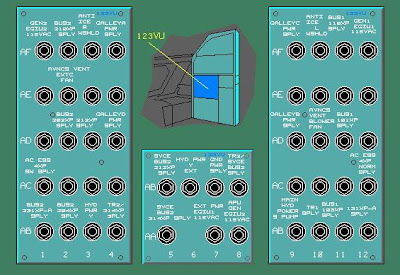








General Avionics Maintenance Knowledge Base in Airbus A320
 Pressed in (Recessed):
Pressed in (Recessed): - In normal operation, no lights, green lights and sometimes blue lights are illuminated
- In normal operation, no lights, green lights and sometimes blue lights are illuminated

 Various furnishings and equipment are fitted in the cockpit for the comfort, convenience and safety of the occupants - Captain, 1st Officer, 3rd Occupant and 4th Occupant.
Various furnishings and equipment are fitted in the cockpit for the comfort, convenience and safety of the occupants - Captain, 1st Officer, 3rd Occupant and 4th Occupant.
Typical range with 150 passengers for the A320-200 is about 2,900 nautical miles (5,400 km). It is powered by two CFMI CFM56-5 or IAE V2500 with thrust ratings between 25,500 to 27,000 pounds force (113 kN to 120 kN).
Technically, the name "A320" only refers to the original mid-sized aircraft, but it is often informally used to indicate any of the A318/A319/A320/A321 family. All variants are able to be ETOPS (Extended-range Twin-engine Operational Performance Standards) certifiedThe direct Boeing competitor is the 737-800.
Technology used in the A320 includes:

| Measurement | A318-100 | A319-100 | A320-200 | A321-200 |
|---|---|---|---|---|
| Cockpit crew | Two | |||
| Seating capacity | 117 (1-class) 100 (2-class) | 156 (1-class) 124 (2-class) | 180 (1-class) 148 (2-class) | 220 (1-class) 185 (2-class) |
| Length | 31.45 metres (103 ft 2 in) | 33.84 metres (111 ft 0 in) | 37.57 metres (123 ft 3 in) | 44.51 metres (146 ft 0 in) |
| Wingspan | 34.10 metres (111 ft 11 in) | |||
| Wing area | 122.6 square metres (1,320 sq ft) | |||
| Wing Sweepback | 25 degrees | |||
| Height | 12.56 metres (41 ft 2 in) | 11.76 metres (38 ft 7 in) | ||
| Cabin Width | 3.70 metres (12 ft 2 in) | |||
| Fuselage Width | 3.95 metres (13 ft 0 in) | |||
| Typical empty weight | 39,300 kilograms (87,000 lb) | 40,600 kilograms (90,000 lb) | 42,400 kilograms (93,000 lb) | 48,200 kilograms (106,000 lb) |
| Maximum take-off weight | 68,000 kilograms (150,000 lb) | 75,500 kilograms (166,000 lb) | 77,000 kilograms (170,000 lb) | 93,500 kilograms (206,000 lb) |
| Cruising speed | Mach 0.78 | |||
| Max. speed | Mach 0.82 | |||
| Take off run at MTOW | 1,355 metres (4,450 ft) | 1,950 metres (6,400 ft) | 2,090 metres (6,900 ft) | 2,180 metres (7,200 ft) |
| Range fully loaded | 3,250 nautical miles (6,020 km; 3,740 mi) | 3,700 nautical miles (6,900 km; 4,300 mi) | 3,000 nautical miles (5,600 km; 3,500 mi) | 3,000 nautical miles (5,600 km; 3,500 mi) |
| Max. fuel capacity | 23,860 litres (5,250 imp gal; 6,300 US gal) | 29,840 litres (6,560 imp gal; 7,880 US gal) | 29,680 litres (6,530 imp gal; 7,840 US gal) | |
| Service Ceiling | 12,000 metres (39,000 ft) | |||
| Engines | 2 × PW6122A 2 × CFM56-5 | 2 × IAE V2500 2 × CFM56-5 | ||